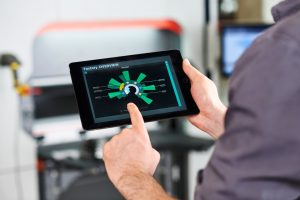 So what does your metal fabricating value chain look like? Can you already determine where your improvements will come from? While the improvements may seem obvious, not all are visible without a careful analysis of what is actually occurring at each step in the value chain. What is obvious from observing the process with an open mind, and what is the data is actually telling you? Decisions for improvements must be based on data and objective reasoning. Besides managing the current metal fabricating value chain, managers need to have a vision of how things could be, given the latest technologies available on the market. Without the vision and knowledge of how things could be, the status quo will remain and improvements will only occur to the current processes and to a finite point.
So what does your metal fabricating value chain look like? Can you already determine where your improvements will come from? While the improvements may seem obvious, not all are visible without a careful analysis of what is actually occurring at each step in the value chain. What is obvious from observing the process with an open mind, and what is the data is actually telling you? Decisions for improvements must be based on data and objective reasoning. Besides managing the current metal fabricating value chain, managers need to have a vision of how things could be, given the latest technologies available on the market. Without the vision and knowledge of how things could be, the status quo will remain and improvements will only occur to the current processes and to a finite point.
The Importance of the Mini Transactions
What is the turn-around time from your quoting process? Many orders are won and lost at this stage and it is critical that the turn-around time is as efficient as possible. Many companies look at these mini transactions that occur before the order, to determine how a company will react to the major transaction of fulfilling their orders. How responsive and how flexible is your company? How efficient are your processes to win the order? Often the case, the decision is based not on the lowest bid, although that helps, but which company has made itself the easiest to work with and the most responsive.
Analyzing the Front End
Once the order is received how quickly does your front office production staff or ERP system break the order down into the required materials, programs, processes, and workflows? How quickly can the engineering and programming staff create the programs from the provided 2D or 3D drawing files? What happens to orders that are released after the office staff leaves for the day? Is there consideration in place for automating the programming process? Programming systems today can take a released order and program the single part, nest the part into existing orders of the same material type and thickness to increase efficiency and total material yield. Once the yield is achieved the program can be released automatically to the machine for processing.
Laser Cutting
Once the order is at the primary process of laser cutting, are raw materials automatically loaded or does it require manual intervention? Does the machine require manual setup intervention or is this achieved automatically with machine automation? Are the materials being processed with competitive laser powers? Fiber lasers have evolved quite quickly over the last 10 years and have approached the 15kW threshold. Did you know that these lasers are able to process 4 to 6 times more parts per unit of time than CO2 lasers? Are you tracking the production data coming from each laser including idle times? With the data comparing what you quoted vs actual, improvements can already be suggested.
Continuous Improvement
This is the first of a multi-part series on analyzing the metal fabricating value chain. Continuous improvement of the process should be part of every business. Not just continuous improvement for the current process, but with an open mind not to be satisfied with the status quo. Continuous improvement and continuous innovation are how leading-edge companies continue to grow and expand. It’s not about how the process is today but the vision of how it could be, given advancements in technology.
By Frank Arteaga, Head of Product Marketing, Bystronic Inc., Hoffman Estates, IL
Voice.bystronic@bystronic.com
